This story from the Australian Aviation archives is from the May 2013 edition of the magazine.
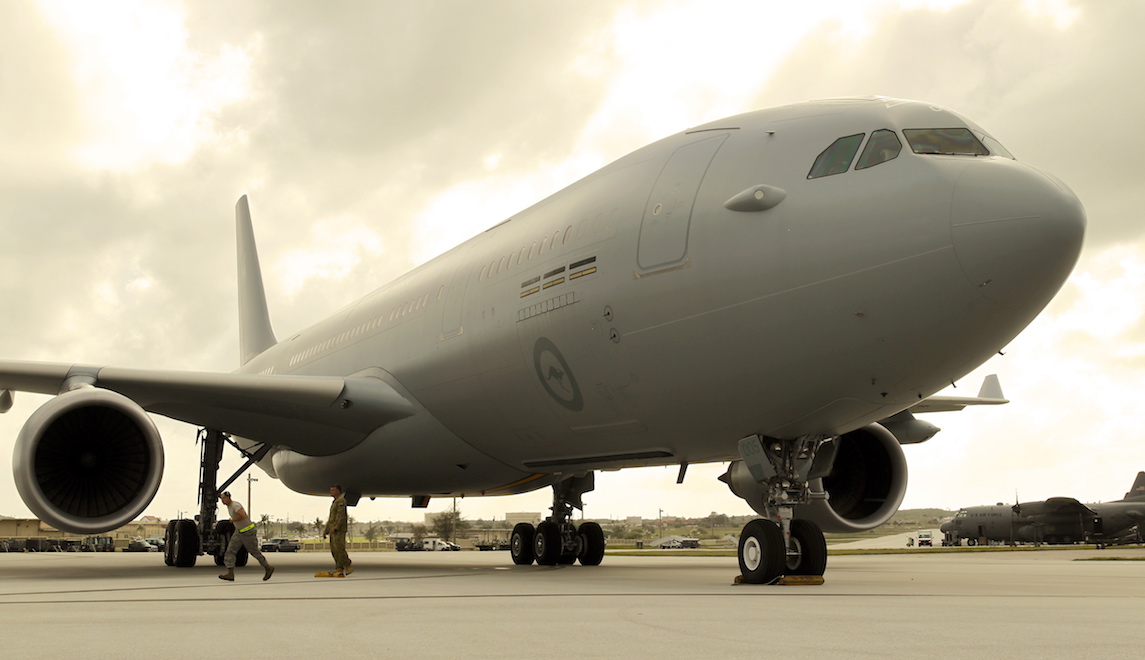
Minister for Defence Stephen Smith announced at the Avalon Airshow on February 26 that the RAAF’s fleet of Airbus Military KC-30A Multi-Role Tanker Transports (MRTT) had achieved an initial operating capability (IOC).
Speaking at the airshow and at a subsequent media conference, Smith highlighted recent advances in the RAAF’s airlift capability, saying Australia now boasts the “complete array” of tactical and heavy capabilities.
“Today I am pleased to announce that the KC-30A MRTT aircraft has reached IOC,” he said. “The MRTT is designed to perform airborne refuelling for air combat aircraft to enhance endurance and range (and) will also provide a further increase in Australia’s overall airlift capability.”
But the announcement came several months after it had been anticipated, with the KC-30 fleet – operated by the RAAF’s 33SQN at Amberley – being made available for tasking for airlift support (ALS) and classic Hornet operational refuelling missions in early 2012, and performing several overseas ALS and exercise support deployments in the period leading up to IOC.
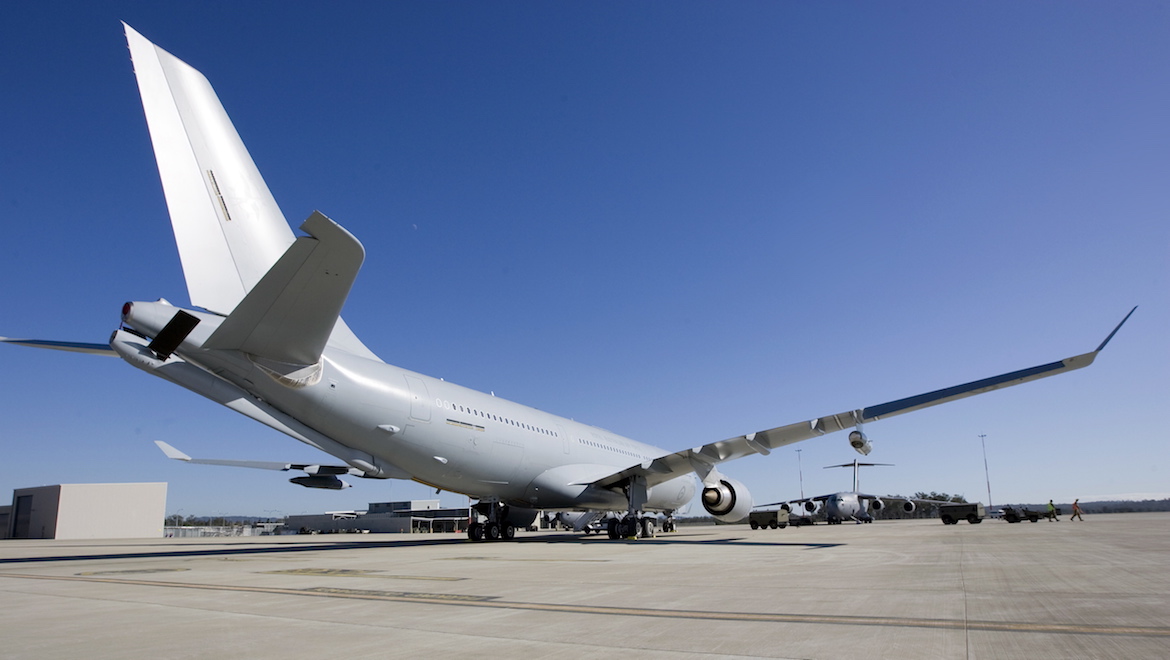
Program history
The road to IOC has been a long one for the ADF and for Airbus Military. The A330 MRTT was selected in April 2004 to fulfil Project AIR 5402 for five aircraft equipped with wing-mounted pods for hose and drogue refuelling and a fuselage centreline refuelling boom. The acquisition contract for the aircraft was signed with then EADS CASA in December 2004.
The MRTT is a substantially modified military derivative of the A330-200 airliner, of which the Qantas Group operates about 20 in Australia. Initial risk-reduction work on the MRTT was done by EADS CASA on a former A310 airliner testbed.
The A310 has the same fuselage cross-section and rear-mounted APU configuration as the A330 and the testbed was equipped with an Airbus-designed advanced refuelling boom system for a flight-test program designed to test the aircraft’s and boom’s flight control systems across a wide flight envelope.
The first RAAF A330 MRTT was rolled out in Spain in June 2007, while the first “green” A330 arrived in Brisbane in June 2008 to undergo conversion by Qantas Defence Services (QDS). The conversion process involved changes to approximately 2,000 structural parts and 5,500 system parts, requiring nearly 22,000 components to be delivered to the conversion centre, and the installation of more than 400 new wiring harnesses with a total of 58km of new cabling.
In November 2007 the RAAF announced it would retire the last of its 707s in June 2008 and that 33SQN would move north to RAAF Amberley to take advantage of that base’s much longer runway, new support facilities, and proximity to Qantas’s Brisbane Airport A330 maintenance facility.
The new $51 million headquarters for 33SQN at Amberley was opened in August 2008 and features a combined squadron headquarters, large hangar and maintenance facility, a ground support equipment shelter, and a new ramp and air movements terminal at the northern end of the base for combined KC-30A and C-17 operations.
But delays in the conversion process of the first aircraft flowed down to the QDS conversion process and to the flight-test plan, resulting in an initial project schedule slip of about six months through 2008 and 2009.
Further delays to the aircraft’s development were exacerbated by a January 2011 incident in which the centreline refuelling boom on the RAAF’s first aircraft – which remains in Madrid as Airbus’s testbed – departed the aircraft during refuelling training with Portuguese air force F-16s. While the boom was lost, the KC-30 and F-16 experienced minor damage and both landed safely.
The first A330 to be converted by QDS successfully achieved its “power on” milestone at its Brisbane conversion facility in August 2009 and began preparations for pre-delivery flight-testing. At this point, it was expected that by mid-2010 two MRTTs would be delivered to the RAAF with a third planned for later that year.
However, by late 2010 no aircraft had been delivered, taking total delays to more than two years from the originally planned late 2008 schedule.
These final delays were attributed mainly to the RAAF’s stringent airworthiness requirements and the failure to be able to establish an acceptable technical baseline from Airbus’s technical documentation, meaning the RAAF was unable to verify the airworthiness of the aircraft’s new systems and thus clear it for operational use.
In October 2010 the project was placed on the Defence Minister’s Projects of Concern (POC) list although it was generally well known within Defence that the POC tag had actually been applied to the project as early as February 2010.
After further work on clarification of Airbus’s technical documentation, the RAAF’s first KC-30A finally arrived at Amberley on May 30 2011. That aircraft – A39-003 – was the third to be built and the second to be modified by QDS.
The second KC-30A and the first QDS modified example followed in June, while -004 followed in October 2011 and -005 was delivered in 2012.
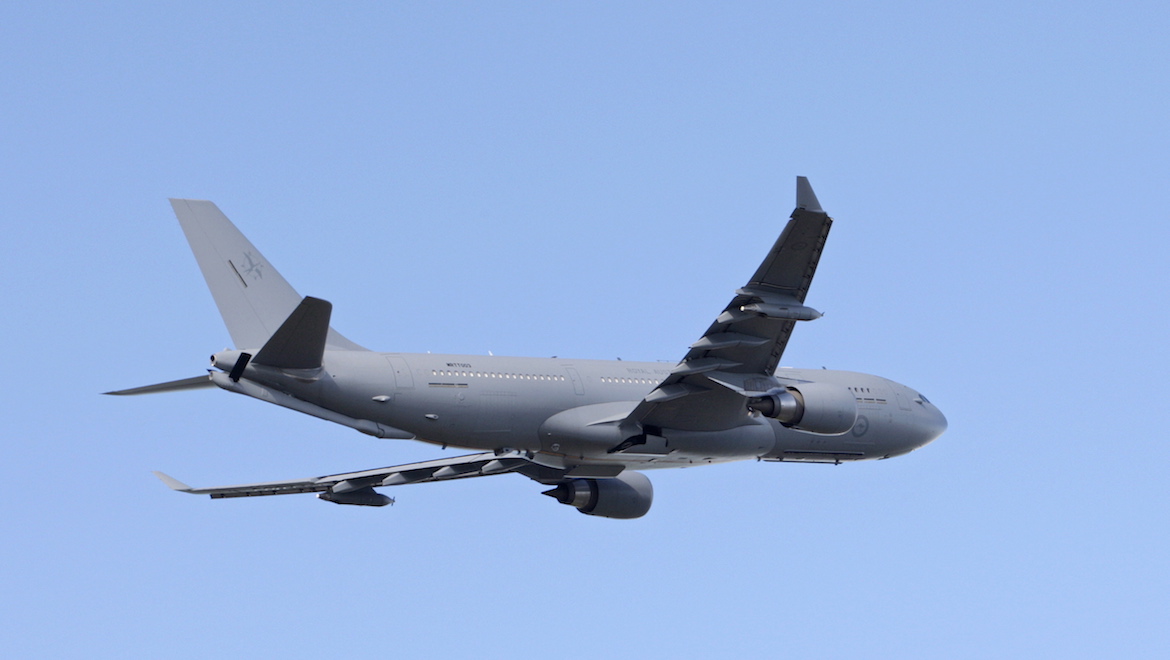
While the RAAF had hoped to have an operational boom flying by late 2012, ongoing software and aerodynamic work has seen this slip and it is now not expected to be available until mid-2014.
With only three ADF aircraft types configured with a receptacle to receive a boom – the E-7A Wedgetail, C-17, and the KC-30 itself – 33SQN has instead focused on developing the KC-30’s hose and drogue refuelling capabilities with the RAAF’s F/A-18 classic and Super Hornet air combat fleets and the aircraft’s impressive air logistics system (ALS) capability for the carriage of passengers and cargo.
VIDEO: A look at the first KC-30A arriving at RAAF Base Amberley in May 2011 from the RAAF YouTube channel.
Transition
The head of the KC-30A transition team, GPCAPT Matt Hegarty, is working closely with multiple stakeholders in facilitating the smooth introduction into service of the aircraft.
On any day, GPCAPT Hegarty has reporting lines to Air Force Headquarters and to the AIR 5402 project team in Canberra, to the Air Commander Australia (ACAUST) at Glenbrook and to the Commander of Air Lift Group (ALG) at Richmond.
“The transition team has two major jobs,” Hegarty told Australian Aviation.
“We started out primarily being staffed to develop capability ideas and concepts, but that has morphed into performing wing-like issues.”
While he doesn’t hold a true wing OC position, the transition team performs a lot of similar functions to a traditional wing in that it is currently the key interface between the higher command and tasking organisations, and the squadron.
“The other half of our job is to liaise with the project team,” he added. “The project has people who are focused on project-related issues, but who need operator input for understanding priorities, for understanding how the capability will ultimately be used and to shape the way they deal with the many outstanding problems. We facilitate their reach into Air Force to fix the issues.”
Hegarty also works closely with Air Force Headquarters to inform them of progress on the project and to take guidance on current priorities, while his responsibility to ACAUST is to advise him, as the RAAF’s airworthiness authority, on airworthiness issues before they’re passed up for decision.
He added that while the IOC announcement probably could have been made earlier, it was likely held over until after 33SQN had successfully completed a major support mission for the deployment of seven F/A-18 classic Hornets to February’s Exercise Cope North on the US island base of Guam.
“For a range of reasons IOC was not seen as a firm definition, so there was some flexibility in how we defined it. It was designed around being realistic about whether we think we’ve really achieved an initial operating capability, and I will say quite happily we achieved it way before the official announcement in my view.
“Prior to IOC the theory was we would be doing training and OT&E [operational test & evaluation],” he added. “But from early to mid-2012 we offered up an aeroplane for tasking on a regular basis as a subset of the full service we will eventually give and since then we have been delivering capability to the ADF.”
WGCDR Geoff Fox, 33SQN’s commanding officer, agreed.
“If you look at what we were measured against for IOC, I think we’ve actually been at that point of being able to do the tasking for some time,” he said. “And I think Cope North was the ultimate demonstration. We took seven Hornets to Guam, participated in an international exercise for two weeks and brought them home again. That was a milestone we had hoped
to achieve from the last airworthiness board late last year and I think we had the capability to do that since then.”

Sustainment and training
A major contractual milestone for the project was the May 2010 signing of the through-life support (TLS) subcontract between Airbus Military and QDS.
This has seen Airbus Military provide engineering, supply and technical data support to QDS to complement its maintenance planning, logistics, deep maintenance and program management responsibilities, and also provides for future contracts to ensure additional support for the military aspects of the fleet, specifically deep maintenance.
Despite being a commercially-derived aircraft, the ADF has chosen to adopt a military-style R-servicing regime instead of the simpler commercial A/B/C check system.
“Something important to remember with the KC-30 is that our acquisition contracts were signed back in 2004 when we hadn’t yet learned any lessons from operating other modern large types like C-17,” explained 33SQN’s senior engineering oficer (SENGO), SQNLDR Andrew Brandham.
“We bought an A330 derivative and instead of keeping the commercial maintenance structure we decided to make it look like a military schedule. So they took the standard Airbus A, B and C checks and turned that into an R1 to R14 schedule.”
The KC-30’s R1 to R4 services are essentially equivalent to the commercial A-check and these are performed on the flightline by 33SQN personnel. Heavier R5 to R14 services cover that work normally done in commercial B and C checks as well as any military-specific work and these are performed by Qantas at Brisbane Airport.
Like Qantas A330s, RAAF KC-30s are booked in to a maintenance slot for scheduled work at Brisbane, while any unscheduled maintenance can be performed at the large hangar at Amberley.
“This aircraft is massive – it’s far larger than anything ever operated by the ADF,” Brandham said. “The hangar at Amberley has afforded me a great deal of risk mitigation for working at heights with our new docking which should be fully commissioned shortly.”
The vast hangar has numerous workshops and stores on two sides including storage and workspaces for the catering and other equipment used by the squadron’s crew attendants, a refuelling boom and pod workshop, and a spares warehouse which is run by QDS personnel.
Other support elements for the KC-30 include the simulation devices for the aircraft, including a full-flight simulator and part-task trainer which incorporates a refuelling operator console, both of which are Level D devices.
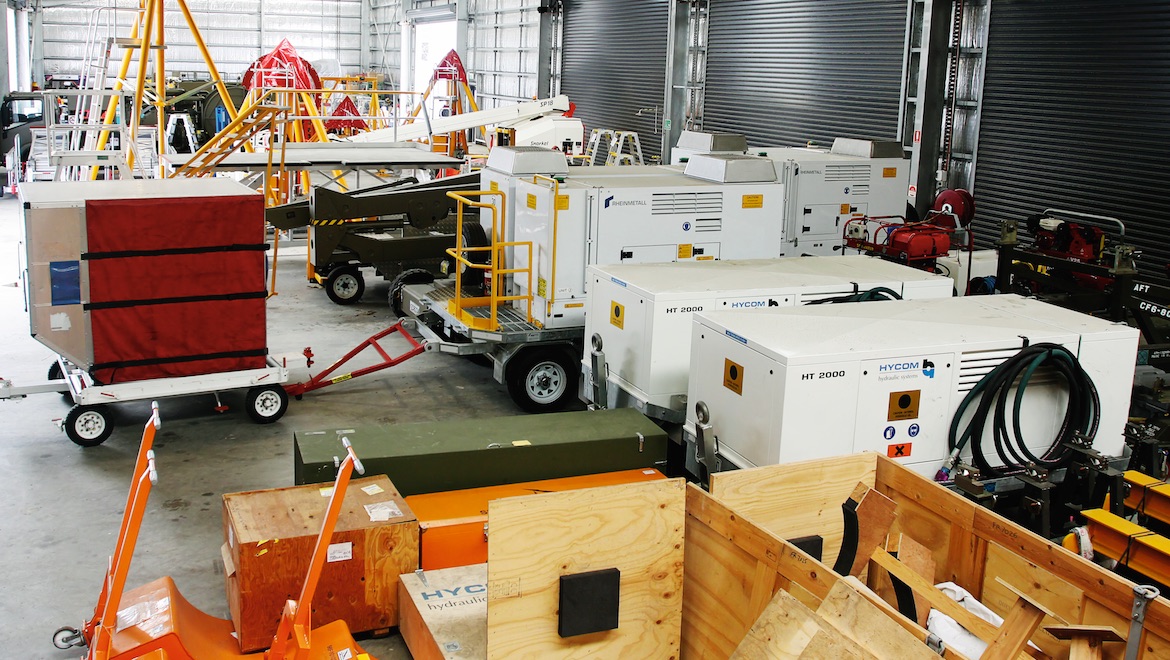
CAE Australia operates the simulators as part of its larger management and support of ADF aerospace simulators contract. For the KC-30A, CAE provides classroom and simulator instruction, courseware development, simulator maintenance and support services, and facilities management.
In January 2013 33SQN received its first in-house KC-30A conversion course graduates.
One of these graduates, FLTLT Seamus O’Donohue, said: “CAE runs the course with material developed by Airbus Military. In reality, the transition from walking out of CAE and across to a real jet left little to the imagination, so that’s a big thumbs-up to CAE as the provider. There are a lot of guys in CAE who are ex-ADF or ex-Qantas – they even have a former US Air Force ‘tanker’ who knows a lot of about ATP 56 [the tanker’s bible] tanking procedures.”
O’Donohue came from a flying tour with 32SQN flying King Airs and before that from 2FTS and the PC-9. He said the CAE trainers also had experience in transitioning from small aircraft to the much larger A330 and other types and were able to impart their knowledge about the differences in ground handling, operations and flight planning, logistics, and other admin items.
“The fidelity of the sim and part-task trainers is another big part of the quality of training,” Fox added.
“You’re already very familiar with the aircraft before you even step into that environment. The biggest part is the size of the aircraft – it’s massive, especially in the takeoff and landing regimes. It has a lot of inertia and we often land it into some small airfields like Richmond, and in some of these airfields you can’t afford to land long and you can’t afford to get high or low on approach. So the training really stresses the handling of the aircraft, things like the awareness of energy, stopping distances, surface conditions, braking action – that’s not something you need to think about much in a PC-9 or a King Air.”
Path to FOC
The RAAF’s necessarily stringent airworthiness requirements will largely drive the path to FOC for the KC-30, especially with the RAAF being a first-of-type operator with little or no global corporate knowledge to draw on.
Even though the aircraft has achieved IOC, 33SQN is still operating under a special flight permit (SFP) as opposed to a full aircraft military type certificate (AMTC), despite performing a number of overseas deployments and having proven its ALS and hose and drogue air- to-air capabilities.
“We are still operating under an SFP primarily due to sustainment issues,” Hegarty explained. “We haven’t moved to a service release and a normal AMTC yet – the SFP exists to allow you to build up to that point. I’m comfortable we’ve built up the operational side to where a service release is reasonable, but for good reason, the HALSPO (Heavy Air Lift Systems Project Office) has said they don’t believe we’re at a point where the current sustainment organisation is sustainable in the longer term. That is normally what you would use to get to an airworthiness board and hopefully justify a service release and an AMTC.”
“The sustainment piece has for a while been suffering the most because we’ve bought a first-of-type aeroplane from a manufacturer that is still getting its processes and procedures in place and who is late in getting the product to us,” he added.
“There are also a number of activities going on in just delivering the aeroplane in its final form which just distracts from the sustainment of the existing aeroplane in its current form.”
While Hegarty says the system is on a positive maturation path, it is still based on intermediate capabilities.
For example, the aircraft’s unique mission planning system which is designed to pull in data from multiple sources and then be uploaded to the aircraft and the aircrew for the conduct of a mission still hasn’t been delivered.
But like most aviation systems there are alternatives and much of the functionality of the mission planning system already exists, albeit in discrete stand-alone systems such as Jeppesen charts.
For the SENGO, his goal for FOC is to establish some depth in the squadron’s engineering workforce.
“My main challenge is I have a quite constrained workforce with not a lot of depth of experience,” said Brandham. “The depth extends to those who were given an A330 course with Qantas and who are still here or the guys who started maintaining this aircraft in June 2011.”
“But we are subject to the posting cycle like everyone else and I do have a lag on the training. This is the first year we’ve had the major turnover of personnel and then had the attendant training burden, so we have less people than we would normally have available. We’ll need to work a bit smarter so I can sustainably rotate the workforce through as the Air Force expects while also meeting our operational needs.”
“The boom is not yet on our radar,” he added. “We do some basic services to make sure it goes up and down and doesn’t leak fuel, but we’ve parked a lot of these until the boom becomes available.”
“And later on we’ll be working towards supporting the installation and testing of the DIRCM (EW countermeasures set). It hasn’t been decided whether that will need to be de-installed before an aircraft goes to Qantas for servicing, but it’s possible the DIRCM installation will be done in Australia in our hangar here.”
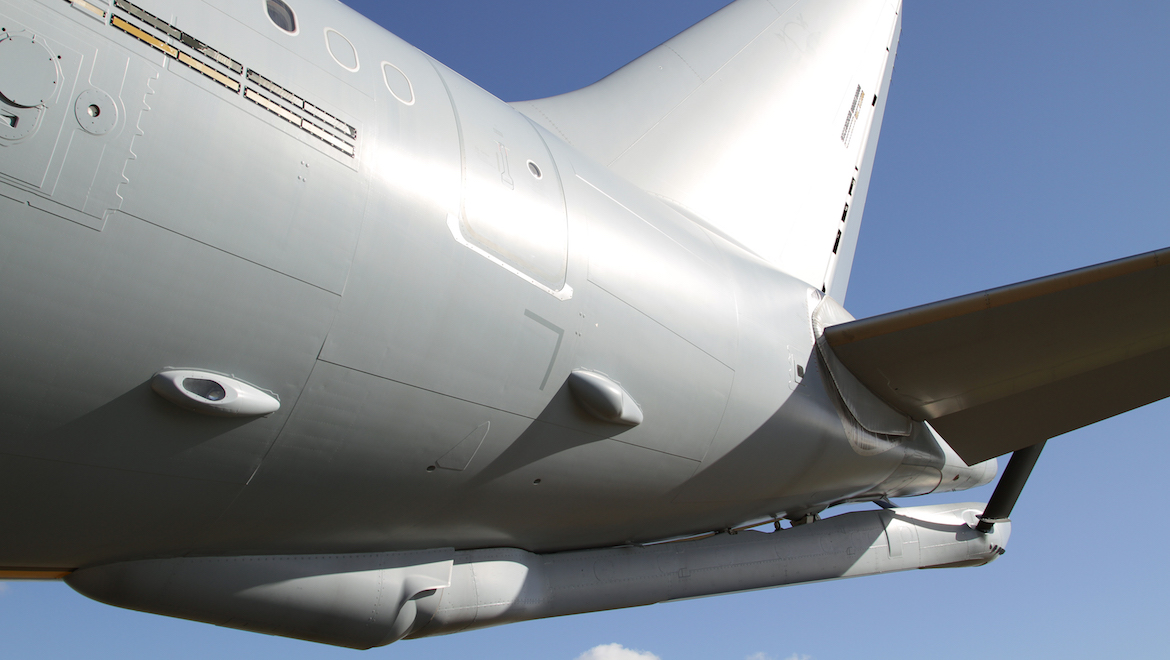
And speaking of the all-important boom, Hegarty and Fox both identified this item as being a major defining capability required in order to be able to offer a full operational capability to government.
Indeed, following the January 2011 separation incident and another in-flight loss of a boom on a UAE KC- 30 last year, Airbus has had to make changes to the operator interface for the ARBS, but Hegarty is confident significant progress is now being made.
“The boom testing is currently underway,” he explained, adding: “Airbus Military did some certification flying earlier this year and that’s now with Spain’s certification authority (INTA) for them to provide a clearance with the new software load.”
“There have been some minor physical changes to the boom controls too, things like a stick-shaker and a follow-up (automatic positioning of the stick in relation to the boom). There is also a range of associated changes with the MFDs (screens) in front of the AROs too.”
One such change to the MFDs will be a reversal of the aircraft symbology on the screen to take into account the fact that the ARO faces backwards in the aircraft. Therefore, the aircraft symbology will, instead of having the nose at the top of screen such as that presented to the pilot and co-pilot who face forward, it will be at the bottom of screen to better reflect the ARO’s view.
“So for FOC, the long pole – so to speak – is the boom,” he added. “But there is also a host of other things that need to be dealt with. There were a lot of contract deliverables that weren’t satisfied during the initial hand-over and a lot of these interface with one another so we can’t just do them one at a time – you have to do them as a whole because they affect certification.”
Fox added that having a working boom is just a part of the equation for 33SQN.
“Once that happens, we then have a big training liability for our pilots and AROs in the use of the boom – the physical use, the procedures, and not just in the tanking aspect but the receiver aspect as well. Whether we do that with another KC-30 or something like a C-17, we haven’t determined yet,” he said.
“It’s not a lot of hardware that’s been modified, it’s predominantly software. But nonetheless, the ARBS has made hundreds of contacts and quite a lot of fuel has been offloaded already in testing, so the probe that goes into the receptacle obviously works. There’s a lot of body of knowledge and a lot of positives to leverage off, so I think when we get the boom it will be a very well-understood system.
“The RAAF’s never had a boom and we haven’t done AAR as an air force for about five years since the retirement of the 707. That’s when we stopped gaining experience, so I expect a fairly onerous and robust training requirement, and we’ll be taking that quite seriously to get it right.
“We will have to develop operational procedures and experience on a new system and new capability for the RAAF,” continued Hegarty.
“Part of that will essentially be an operational test and evaluation where we do a range of testing that will ultimately provide receiver clearance from a KC-30 to another KC-30. That includes also receiving as well as tanking. That is a fundamental aspect of the capability, being able to take gas on. We think KC-30 to KC-30 is probably the wise idea to pursue first.”
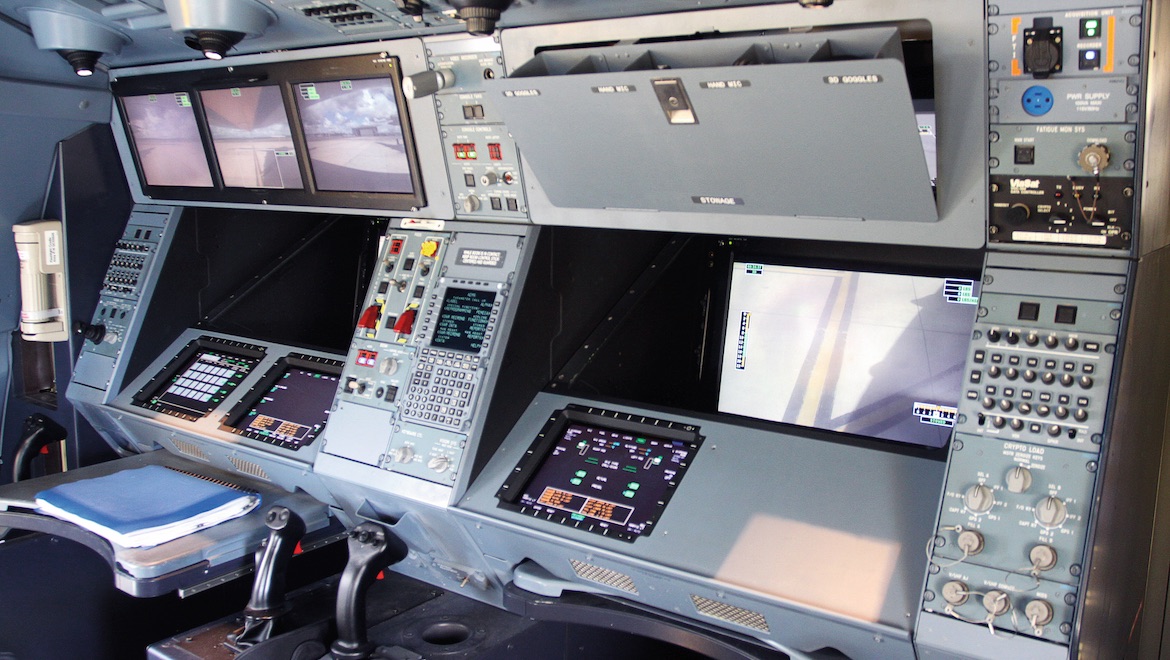
FOC still undefined
So with an undefined FOC date and a still experimental boom, the transition team and 33SQN will instead consolidate over the next year and work towards finding solutions to current issues and anticipating future issues.
“We’ve found sustainment issues with the pods and I’ll be surprised if we don’t find the same things with the boom,” said Hegarty in closing. “And come FOC, this won’t be all fixed. There will still be outstanding issues that come with operating a first-of-type aircraft – we’re still ahead of the RAF, the UAE and the Saudis, and we’ll be dealing with issues for some time to come.
“There haven’t been too many surprises,” he added. “In fact, I guess we’ve been surprised that it can do what it does. More than once we have found ourselves saying, ‘Wow, that’s fantastic, you moved how many people in what time?’ It’s one thing to see it in the brochure, but to actually do it . . . the reach of this aeroplane is just awesome. It’s hyperbole I know, but ‘game changer’ is not an unreasonable phrase in terms of, when you combine that with what we can do with a C-17 . . . wow!”
Fox echoed Hegarty’s enthusiasm for the KC-30’s potential.
“As other operators mature their capability – the UK, Saudi, and UAE – the body of knowledge will grow rapidly. We’re very willing to share information and we’re keeping communications open. In fact, we had a new customer who hasn’t announced yet with us here recently to fly with us and to get a good understanding of the capability. There is a user group already established, and the transition team is working on growing that. The UAE and other operators looking at tanker replacements have been very interested in what we’re doing.”
“It’s been a remarkable journey,” said Fox. “The declaration of IOC was a key milestone, but the lead up to that really showed us what a remarkable aeroplane this really is. It’s just a long journey introducing a new type.”
VIDEO: RAAF KC-30A in air-to-air refuelling of Super Hornets during Exercise Talisman Saber in 2013, again from the RAAF YouTube channel.
This story first appeared in the May 2013 edition of Australian Aviation. To read more stories like this, become a member here.












